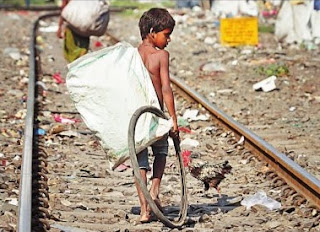In India, education at backseat for poor families…Needs review of provisions of RTE and Child Labour Acts
Needs review of provisions of RTE and Child Labour Acts
Despite introduction of Right to Education Act in 2009, the children are still far from the first step of education in India particularly from poor families who have problems providing adequate clothing and food for their children and this is the reason that sometimes requires child labour in the fields or in the household often to help with younger siblings.
Under the Act, the provisions have been made for education to the children between 6-14 years of age and both State and Centre governments are to bear the burden on this account to educate the children.
Not only this, the state governments even extend number of incentives from time to time, to allure the students to join the schools by providing mid-day meal, uniforms, books, bi-cycles etc. through its Sarv Sikhya Abhiya campaign throughout the country.
The Education Department too is working on this issue to motivate the children and parents but still the children of tender age are seen roaming on the road collecting waste saleable items from the garbage, working on the shops, cleaning utensils at the tea shops, at brick kilns or working as labourer at the factories, construction sites etc. Their real aim is only to earn for livelihood of family members.
Such children too had a feeling to go to the school but they are pushed to various labour works in the early morning like other children to the school. They have become victim of the circumstances. Non joining the school also gives birth to tribulations like divorce, alcoholism and domestic violence can often presage school dropout. The matter does not end here, the prostitution, membership of street gangs or of beggars’ networks almost always lead to children dropping out of school.
The Education Department has even reserved 25 per cent seats for the poor students in the schools in the private schools but the Right to Education has no meaning for the children the command of whose is in the hands of their uneducated parents. Siblings’ educational example is much more influential. Families in which elder siblings have left school early often see the younger ones do the same.
Another major factor involved is that social activists are some afraid to have interaction with the parents of such children for motivational purposes because of their involved in the high crimes which increases the dropout.
Frankly speaking, mere opening of Anganwadi centres or government schools and recruiting staff, at a short distances and making policies while sitting the four-walled AC rooms would not suffice unless and until the employers who engage the young children brought to books with stringent measures so that they could acquire education and contribute something for the development of their families, society and nation as well.
At the same time, the Child Labour (Prohibition and Regulation) Act, 1986 which is one the most debated acts regarding children in India and outlines where and how children can work and where they can not needs to be reviewed with reference to Right to Education to all.
After detailed survey of such children, discussions with the old timers, retired educationists, the outcome was only that either the child labour after the school hours is allowed or instead of incurring heavy budget on implementation of Right to Education for all, an incentive equal to the average earning of a child is credited direct to the accounts of the parents with the condition that your kid must go to school regularly. Only such arrangements can fulfill the real meaning of education to all in India.
Under the Act, the provisions have been made for education to the children between 6-14 years of age and both State and Centre governments are to bear the burden on this account to educate the children.
Not only this, the state governments even extend number of incentives from time to time, to allure the students to join the schools by providing mid-day meal, uniforms, books, bi-cycles etc. through its Sarv Sikhya Abhiya campaign throughout the country.
The Education Department too is working on this issue to motivate the children and parents but still the children of tender age are seen roaming on the road collecting waste saleable items from the garbage, working on the shops, cleaning utensils at the tea shops, at brick kilns or working as labourer at the factories, construction sites etc. Their real aim is only to earn for livelihood of family members.
Such children too had a feeling to go to the school but they are pushed to various labour works in the early morning like other children to the school. They have become victim of the circumstances. Non joining the school also gives birth to tribulations like divorce, alcoholism and domestic violence can often presage school dropout. The matter does not end here, the prostitution, membership of street gangs or of beggars’ networks almost always lead to children dropping out of school.
The Education Department has even reserved 25 per cent seats for the poor students in the schools in the private schools but the Right to Education has no meaning for the children the command of whose is in the hands of their uneducated parents. Siblings’ educational example is much more influential. Families in which elder siblings have left school early often see the younger ones do the same.
Another major factor involved is that social activists are some afraid to have interaction with the parents of such children for motivational purposes because of their involved in the high crimes which increases the dropout.
Frankly speaking, mere opening of Anganwadi centres or government schools and recruiting staff, at a short distances and making policies while sitting the four-walled AC rooms would not suffice unless and until the employers who engage the young children brought to books with stringent measures so that they could acquire education and contribute something for the development of their families, society and nation as well.
At the same time, the Child Labour (Prohibition and Regulation) Act, 1986 which is one the most debated acts regarding children in India and outlines where and how children can work and where they can not needs to be reviewed with reference to Right to Education to all.
After detailed survey of such children, discussions with the old timers, retired educationists, the outcome was only that either the child labour after the school hours is allowed or instead of incurring heavy budget on implementation of Right to Education for all, an incentive equal to the average earning of a child is credited direct to the accounts of the parents with the condition that your kid must go to school regularly. Only such arrangements can fulfill the real meaning of education to all in India.






